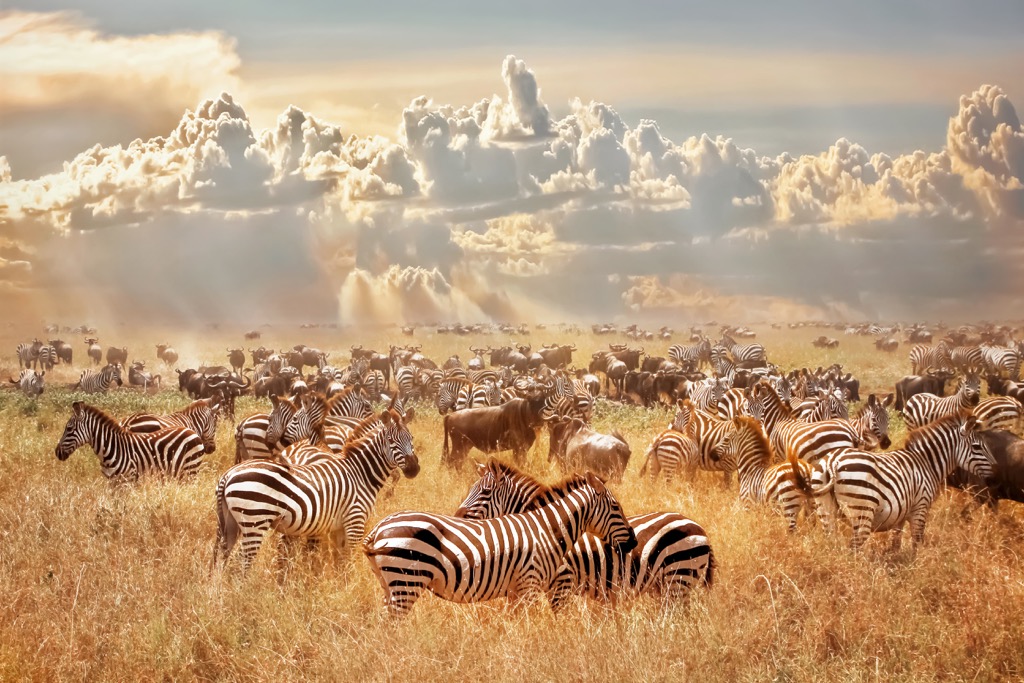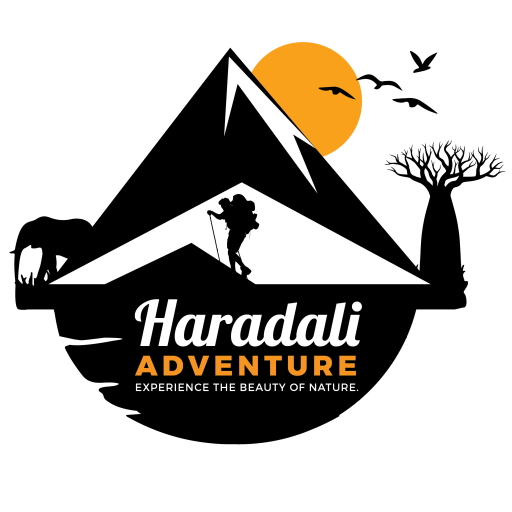Tarangire National Park
Tarangire National Park, located in the heart of Tanzania, is one of the most enchanting and lesser-known gems of East Africa. Spanning over 1,100 square miles (2,850 square kilometers), Tarangire offers a diverse ecosystem filled with a unique blend of wildlife and awe-inspiring landscapes. The park is famed for its vast elephant herds, ancient Baobab trees, and the iconic African savannah that stretches as far as the eye can see.
The Heart of the Elephant Kingdom
Tarangire is a sanctuary for one of the largest populations of elephants in East Africa. The park’s lush wetlands and network of river valleys make it an ideal habitat for these magnificent creatures. Visitors are often greeted by large herds of elephants, with their massive tusks and gentle demeanor, roaming through the park in search of food and water. The sight of these majestic animals in their natural habitat is a true highlight of any safari.

A Landscape Like No Other
One of the most distinctive features of Tarangire is its dramatic landscapes. The park is a vast expanse of golden savannah, interspersed with towering Baobab trees, riverine forests, and grassy plains. These ancient trees, some more than 1,000 years old, are a symbol of Africa’s timeless beauty and add a magical quality to the park. Whether you’re gazing at the colossal Baobabs at sunset or enjoying a game drive through the open plains, Tarangire’s landscape is as awe-inspiring as the wildlife that inhabits it.
The Circle of Life in Tarangire
While Tarangire is best known for its elephants, the park is also home to a wide variety of wildlife. It’s a place where the drama of the African wilderness unfolds daily. Lions, leopards, cheetahs, giraffes, zebras, wildebeests, and a multitude of bird species call this place home. The park is also an important stop for migratory animals, especially during the dry season when animals converge around the Tarangire River and its waterholes, creating a stunning spectacle of nature.

A Birdwatcher’s Paradise
Tarangire is a birdwatcher’s dream. With over 550 species recorded, from vibrant lilac-breasted rollers to the majestic raptors circling above, the park offers a wealth of birdlife that captivates both amateur birders and seasoned ornithologists. Whether you’re on a guided safari walk or simply observing from your lodge, Tarangire presents endless opportunities to spot and photograph rare and colorful bird species.
Seasonal Rhythms: The Best Time to Visit Tarangire
Dry Season (June – October)
The best time to visit Tarangire is during the dry season, when the wildlife congregates around the limited water sources. This is the time when the park is most alive, with large herds of elephants and predators such as lions and leopards hunting by the riverbanks. The landscape’s golden hues make it a photographer’s paradise.
Green Season (November – April)
For those seeking a quieter, more serene experience, the green season offers lush landscapes, vibrant vegetation, and the birth of many young animals. The park is less crowded during this period, offering a more intimate safari experience.
What Makes Tarangire Unique?
Unlike some of the more famous parks in Tanzania, Tarangire offers an intimate and more personal safari experience. Its relative seclusion means fewer tourists, allowing you to enjoy the beauty of the park without large crowds. The park’s diversity in both its wildlife and habitats makes it a perfect destination for those looking for an authentic African adventure.
A Safari to Remember
Whether you’re embarking on a thrilling game drive, taking a walking safari through the park’s diverse ecosystems, or simply relaxing by the river with a sundowner in hand, Tarangire offers an unforgettable adventure. The towering Baobab trees, the vast herds of elephants, and the dramatic landscapes combine to create one of the most unique and enchanting safari experiences in Africa.

Visiting Tarangire is not just a safari; it’s an opportunity to connect with nature in its purest form, to witness the timeless rhythms of life in the wild, and to feel the heartbeat of Africa.
The Circle of Life in Tarangire
In Tarangire, nature unfolds in its most raw and spectacular form. The park is an essential part of the African ecological system, where predator-prey dynamics, animal migrations, and seasonal changes work together to create a perfectly balanced ecosystem. Watching a lion hunt in the early morning light or seeing elephants drink at a waterhole at sunset is a reminder of the wild beauty that Tarangire preserves.
A Destination Like No Other
Tarangire is a place where wildlife and landscape intertwine, creating an experience that is both thrilling and tranquil. From the sounds of lions calling in the distance to the sight of elephants ambling beneath the Baobab trees, every moment in Tarangire is a gift from nature. It’s a destination that’s as much about the journey as it is about the destination.

An Experience That Lasts Forever
A visit to Tarangire National Park isn’t just a safari; it’s a transformative experience. Whether you’re marveling at the elephants, admiring the Baobabs, or simply soaking in the landscape, the park offers a connection to the wild that will stay with you forever. It’s an adventure that offers not just wildlife sightings but a deeper understanding of the balance and beauty of nature.
Plan Your Visit to Tarangire National Park
Tarangire is ready to welcome you on a journey of discovery. Whether you’re planning a family safari, a romantic getaway, or a solo adventure, Tarangire promises an experience like no other.
Why Visit Tanzania?

Tanzania is home to some of the world’s most iconic destinations, including:
- Serengeti National Park: Known for the Great Migration and incredible wildlife.
- Ngorongoro Crater: A UNESCO World Heritage site and one of the best places to see the Big Five.
- Mount Kilimanjaro: The highest peak in Africa, offering various trekking routes.
- Zanzibar: A tropical island paradise with pristine beaches and rich history.
No matter when you visit, Tanzania offers unparalleled opportunities for adventure, nature, and culture.
Best Time to Visit Tanzania

The best time to visit Tanzania depends on your experience preferences. For wildlife safaris, the dry season from June to October offers the best game viewing, while January to February is ideal for the Great Migration calving season in the Serengeti. If you’re climbing Mount Kilimanjaro, the best months are January to March and June to October for clear skies. Zanzibar’s beaches are perfect from June to October and December to February. Avoid the long rains (March to May) when some lodges close, though the landscape is lush and less crowded.
Understanding Tanzania's Seasons

Tanzania has two primary seasons: the dry season and the wet season. The timing of your trip will depend on your preferred activities, whether you want to enjoy wildlife safaris, beach vacations, or mountain trekking.
Dry Season (June to October): Best for Safaris and Wildlife Viewing
The dry season in Tanzania typically lasts from June to October. This is the most popular time for safaris, as it coincides with excellent wildlife viewing conditions. The dry season is ideal for those interested in seeing large game, including the Big Five.
- Weather: Warm and sunny, with temperatures ranging from 25°C (77°F) to 30°C (86°F). Nights are cooler, especially in higher altitudes like the Ngorongoro Crater.
- Wildlife: During this period, animals congregate around waterholes, and vegetation is sparse, making wildlife easier to spot. This is also the time to witness the Great Migration in the Serengeti, especially from July to October, when thousands of wildebeest cross the Mara River.
- Why Visit: Ideal for a safari experience with clear skies, fewer mosquitoes, and the best chance of seeing a variety of wildlife.
Wet Season (March to May): Best for Lush Landscapes and Fewer Crowds
The wet season in Tanzania occurs from March to May. While the rain can make certain roads impassable, the wet season also offers a unique and quieter experience for those willing to brave the conditions.
- Weather: Expect heavy rainfall, especially in April and May, with temperatures ranging from 23°C (73°F) to 28°C (82°F). Rain showers are usually short but intense.
- Wildlife: The wet season is not the best for wildlife viewing, as animals spread out across the park in search of food. However, the lush greenery makes the landscapes incredibly beautiful, and birdwatching is at its peak.
- Why Visit: Ideal for visitors looking to avoid the crowds and enjoy a more serene, peaceful experience. This is also a great time to visit the beaches of Zanzibar, where the rainfall is less intense compared to mainland Tanzania.
Shoulder Seasons (January to February): Best for Calving Season and Mild Weather
The shoulder months of January and February are between the wet and dry seasons. These months offer mild weather and excellent opportunities to see the wildebeest calving season in the Serengeti.
- Weather: Warm but not too hot, with temperatures around 24°C (75°F) to 30°C (86°F). There is less rain compared to the wet season, making it a great time for outdoor activities.
- Wildlife: January and February are prime months to witness the Great Migration’s calving season in the southern Serengeti. This is a thrilling time for wildlife enthusiasts, as you’ll see thousands of wildebeest give birth, attracting predators like lions and cheetahs.
- Why Visit: Perfect for those looking to witness one of nature’s most incredible events—the birth of wildebeest calves—and enjoy pleasant weather for trekking and other activities.
The Best Time to Visit Tanzania Based on Activities

Safari in Serengeti and Ngorongoro Crater
- Best Time: June to October (dry season)
- Why: This is when the animals are easier to spot due to the dry conditions and fewer places to hide. It also coincides with the Great Migration in the Serengeti, which is a once-in-a-lifetime experience.
Climbing Mount Kilimanjaro
- Best Time: June to October (dry season) and January to February (shoulder season)
- Why: The weather is clearer during the dry season, providing better trekking conditions. If you’re planning to summit Kilimanjaro, these months offer the least amount of rain and the best visibility.
Zanzibar Beach Holiday
- Best Time: June to October (dry season) and December to February (shoulder season)
- Why: The dry season provides the most pleasant conditions for lounging on Zanzibar’s beautiful beaches. December to February is also a good time if you want to avoid the peak season crowds but still enjoy sunny weather.
Accommodation Options in Tanzania

Tanzania offers a wide range of accommodations to suit different budgets, from luxurious lodges in the Serengeti to more affordable campsites in Ngorongoro.
- Luxury: Four Seasons Safari Lodge Serengeti, Ngorongoro Crater Lodge
- Mid-Range: Serengeti Serena Safari Lodge, Ngorongoro Sopa Lodge
- Budget: Mbugani Tented Camp, Simba Campsite






